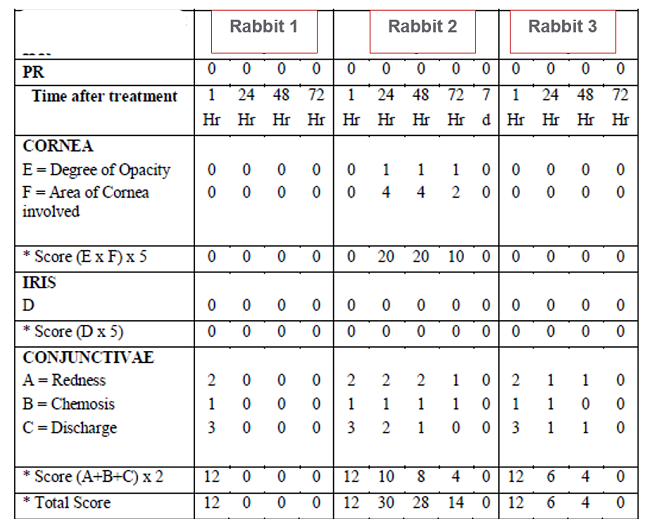Examples of Eye Irritation Classification for Substances and Mixtures under GHS
Little Pro on 2019-03-07
We have summarized GHS classification criteria for eye irritation and serious eye damage in previous article. Now we would like to give you a few practical examples of eye irritation classification for substances and mixtures under GHS.
Example 1: Substance Classification Based on Animal Data
Let's assume that we have conducted a reliable OECD TG 405: Acute Eye Irritation/Corrosion study on 3 rabbits for a substance and have obtained the following test result. It is a typical Draize eye test and the scores given are weighted scores. All effects observed are reversible within 21 days. More info about Draize's grading system can be found here.

What we need to do next is to analyze above result and compare it with below GHS classification criteria:
| Category | GHS Classification Criteria |
|---|---|
|
Category 1 (Causes serious eye damage) |
Animal experience or test data that the substance produces either:
|
|
Category 2/ 2A (Irritant) |
Animal experience or test data that indicate that the substance produces a positive response in at least 2 of 3 tested animals of:
calculated as the mean scores, following grading at 24, 48, and 72 hours; and such effects are usually reversible within 21 days.
|
|
Category 2B (Mild irritant) |
If a substance meets classification criteria for 2A and such effects can be reversible within 7 days, the substance can be classified as 2B.
|
To determine correct GHS eye irritation classification, we firstly need to calculate the mean score of corneal opacity, iritis and conjunctival edema and conjuntival chemosis for each animal following grading at 24, 48, and 72 hours. Note: we only need to consider the grading for the degree of opacity, iritis, redness (edema) and chemosis. The total scores given in the table are used for other purpose and not used for GHS classification.
- Corneal opacity: Only 1 animal has reduced corneal opacity. The mean score = (1+1+1)/3 = 1.
- Iritis: None of the 3 animals has iritis.
- conjunctival edema: 2 animals (rabbit 2 and rabbit 3) have conjunctival edema. The mean score for rabbit 2 is (2+2+1)/3 = 1.7. The mean score for rabbit 3 is (1+1+0)/3 = 0.7. Both scores are less than 2.
- conjunctival chemosis: 2 animals (rabbit 2 and rabbit 3) have conjunctival chemosis. The mean score for rabbit 2 is (1+1+1)/3 = 1. The mean score for rabbit 3 is (1+0+0)/3 = 0.3. Both scores are less than 2.
Clearly the substance does not meet GHS classification criteria for eye irritation category 2/2A or 2B since the mean scores are low. Thus the substance will not be classified as irritating to eyes.
Note: In vitro eye irritation test data can also be used to derive GHS classification. This is not covered in this article.
Example 2: Mixture Classification Where Additivity Principles Apply
If a mixture contains two or more ingredients with the same or similar hazards (eye irritant, skin irritant), the concentration of the hazardous ingredients shall be added first. Then we determine the GHS classification of the mixture by following the table below. However, this additivity principle does not apply in some exceptional cases.

Let's assume that we have a mixture containing the following 2 components:
- Ingredient A, Skin Corrosion Category 1, 0.5% w/w
- Ingredient B, Eye Irritation Category 2A, 6% w/w
The mixture will then be classified as Eye Irritation Category 2A since (10 x 0.5% + 6%) >=10%.
Example 3: Mixture Classification Where Additivity Principles Do Not Apply
Certain chemicals such as strong acids (pH<=2), strong bases (pH>=11.5), inorganic salts, aldehydes, phenols and surfactants may not be classified using above additivity approach. For those chemicals, you may refer to the non-additivity approach below.

Let's assume that we have a mixture containing the following hazardous components:
- Surfactant A, Eye Irritation Category 2A, 6% w/w
- Other components: not irritating to skin or eyes
In this case, we cannot use additivity approach because the hazardous ingredient is a surfactant. The mixture then will be classified as Eye Irritation Category 2A directly since the concentration of the hazardous surfactant is greater than 3%.
Reference
Having Questions?
We do not provide consultancy services. If you have questions or need any help, please contact our sponsor. You may also find an expert in CSP business directory below. If you are a consultant, you may get yourself listed in CSP business directory (free) or sponsor this page to leave your contact info on this page..

Tags: Topics - GHS, GHS Classification